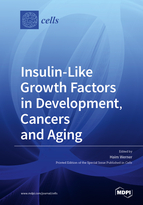Insulin-Like Growth Factors in Development, Cancers and Aging
A special issue of Cells (ISSN 2073-4409). This special issue belongs to the section "Cellular Aging".
Deadline for manuscript submissions: closed (31 March 2020) | Viewed by 80259
Special Issue Editor
Interests: insulin-like growth factors; IGF1 receptor; mechanisms of transcription; tumor suppressors
Special Issues, Collections and Topics in MDPI journals
Special Issue Information
Dear Colleagues,
Since their discovery in the late 1950s, insulin-like growth factors (IGF) have generated a significant level of interest in many areas of biology and medicine, including endocrinology, pediatrics, growth and development, metabolism, nutrition, aging and longevity and, finally, cancer research. IGF1, which was initially identified as the mediator of growth hormone action, is regarded as a key player in numerous cellular and organismal processes. The signaling pathways elicited by IGF1 have been extensively characterized in biochemical and molecular terms over the past 40 years. However, fundamental questions regarding basic differences between mechanisms of action of IGF1 and the closely related insulin molecule are yet to be resolved. IGF1 displays one of the most potent anti-apoptotic and pro-survival activities amongst all growth factors identified to date. Therefore, the IGF1 axis and, in particular, the IGF1 receptor emerged as a promising therapeutic target in oncology. In addition, the IGF1 system plays an important role in aging processes and abrogation of the growth hormone-IGF1 endocrine axis is associated with increased lifespan. This Special Issue of Cells will provide a collection of modern articles dealing with the role of IGF1 action in cancer biology, aging, and development. The articles explore basic and clinical aspects of the IGF1 system, including post-genomic analyses as well as novel, personalized approaches to target the IGF1R in oncology.
Prof. Haim Werner
Guest Editor
Manuscript Submission Information
Manuscripts should be submitted online at www.mdpi.com by registering and logging in to this website. Once you are registered, click here to go to the submission form. Manuscripts can be submitted until the deadline. All submissions that pass pre-check are peer-reviewed. Accepted papers will be published continuously in the journal (as soon as accepted) and will be listed together on the special issue website. Research articles, review articles as well as short communications are invited. For planned papers, a title and short abstract (about 100 words) can be sent to the Editorial Office for announcement on this website.
Submitted manuscripts should not have been published previously, nor be under consideration for publication elsewhere (except conference proceedings papers). All manuscripts are thoroughly refereed through a single-blind peer-review process. A guide for authors and other relevant information for submission of manuscripts is available on the Instructions for Authors page. Cells is an international peer-reviewed open access semimonthly journal published by MDPI.
Please visit the Instructions for Authors page before submitting a manuscript. The Article Processing Charge (APC) for publication in this open access journal is 2700 CHF (Swiss Francs). Submitted papers should be well formatted and use good English. Authors may use MDPI's English editing service prior to publication or during author revisions.
Keywords
- insulin-like growth factors (IGF1, IGF2)
- IGF1 receptor
- IGF binding proteins
- mechanisms of cancer
- personalized medicine
- targeted therapy
- longevity
- aging
- development







